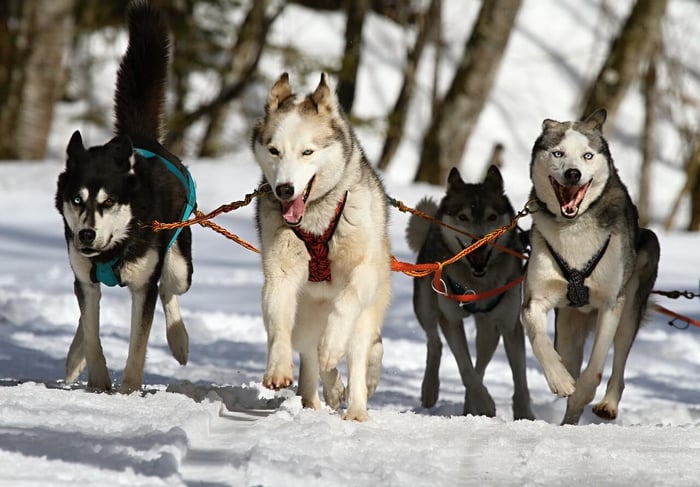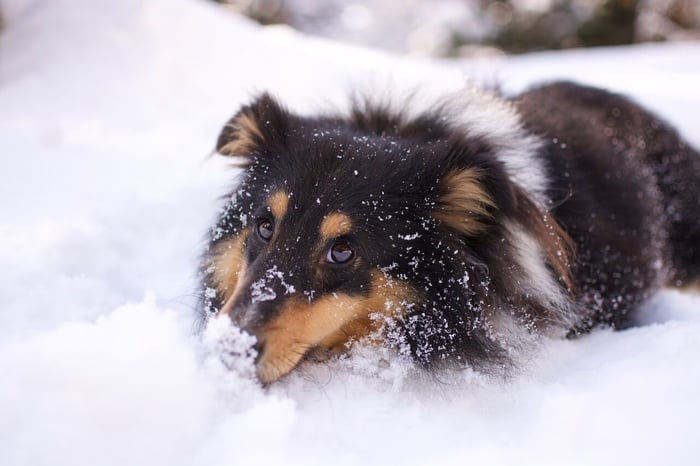Do you know how cold is too cold for dogs? Did you know it varies based on breed, age, coat color, and more?
Most dogs are fine when temperatures are above 45°F, but sensitive dogs may get uncomfortable in lower temperatures. When it's freezing outside, your dog can be at risk of hypothermia. Temperatures lower than 20°F put all dogs at risk.
Of course, there are so many other factors that can help you determine if it's safe to go outside with your dog. A Husky can often enjoy extended periods in the snow as long as they have somewhere safe to warm up when they're ready, while a Chihuahua may suffer even before the temperatures drop below freezing.
In this article, we'll discuss what temperatures are safe for dogs, ways to keep your dog warm in the winter months, signs of hypothermia, and more.
Understanding Dog Breeds & Cold Tolerance: How Cold Is Too Cold for Your Dog?
Not all dogs are built the same when it comes to handling cold weather. While some dog breeds were made for snowy adventures, others start to feel cold the moment the temperature drops. So, how cold is too cold for your dog? The answer depends on several key factors—breed, size, age, coat type, body fat, and overall health status.
Breed and Coat Type Matter
Dog breeds like Siberian Huskies and Alaskan Malamutes have thick coats and higher cold tolerance, making them better suited for northern climates and extremely cold weather. These dogs often enjoy the great outdoors even when temperatures fall well below freezing.
But for toy breeds, small dogs, or breeds with short hair and thin coats—like Chihuahuas or Greyhounds—freezing temperatures can become dangerous quickly. These cold-averse dogs lose body heat faster and may need extra dog clothing to stay warm.
Age and Health Conditions
Puppies, older dogs, and sick dogs often have a harder time regulating body temperature, which means they’ll feel uncomfortable faster in cold climates. Their immune systems may also be weaker, making them more prone to hypothermia and illness during winter weather.
If your senior dog or pup has any health conditions, it’s best to limit their time outdoors during cold temperatures, and always monitor for signs of distress.
Size and Body Fat
Large dogs with more body fat can typically withstand the cold for longer, while small dogs and lean breeds lose heat much more quickly. A small pup might need dog booties, a warm coat, and shorter winter walks, especially when wind chill or snow is in the forecast.
Signs Your Dog Is Too Cold
Every pet parent should watch for clear signs that the cold is too much for their dog. If your dog shows signs like shivering, lifting dog paws off the ground, or refusing to continue a dog walk, it’s time to head inside. These are early indicators that your dog feels cold and needs warmth immediately.

Dog's Normal Body Temperature and Signs of Hypothermia
Understanding your dog’s normal body temperature is key to keeping them safe during cold weather. Most dogs maintain a body temperature between 101°F and 102.5°F. When cold temperatures cause that to drop below 100°F, your dog may be at risk of hypothermia—a dangerous and potentially life-threatening condition.
What Is Hypothermia in Dogs?
Hypothermia occurs when your dog’s body temperature falls too low to maintain normal bodily functions. It’s most common during freezing temperatures, snow, or extended exposure to extremely cold weather, especially in small dogs, puppies, senior dogs, or dogs with health conditions.
Even healthy dogs can become vulnerable if they stay outside too long during winter walks or spend time outdoors without proper protection like dog clothing or booties.
Signs Your Dog May Have Hypothermia
Pet parents should act fast if their pup shows signs of being too cold. Here are the most common red flags:
Shivering or trembling that doesn’t stop
Lethargy or sluggish movements
Whining, anxiety, or restlessness
Cold ears, paws, or tail
Pale gums or trouble breathing
Stiff muscles or difficulty walking
Loss of coordination or collapse
If your dog feels cold to the touch, especially on their paws or ears, it's a sign their body temperature is dropping. Cold averse dogs and those with thin coats are especially at risk when weather conditions worsen.
What to Do if You Suspect Hypothermia
If you think your dog is too cold, get them inside right away. Dry them off if they’re wet, wrap them in warm blankets, and use a good insulator like a heated bed or thermal pad. Avoid using hot water bottles or direct heat, which can cause shock.
If symptoms persist or worsen, contact your vet immediately—hypothermia is a medical emergency and needs prompt attention.
Factors Influencing a Dog's Cold Tolerance
There are many factors that determine how long a dog can be in the cold. These include:
Breed and Size: Small dogs or toy breeds like Chihuahuas get cold more quickly than larger dogs like Bernese Mountain Dogs or healthy Arctic breeds.
Age: Senior dogs and puppies have a harder time regulating their body temperature compared to young adults.
Coat Type: Dogs with double coats can withstand harsher temperatures better than those with thin coats.
Weight and Health: Heavier dogs generally stay warmer for longer, while sick dogs are more susceptible to cold-related health issues.
Activity Level: A dog walk or winter walk can keep a dog’s body moving and warm, but a dog lying still will get colder faster.
Wind Chill and Weather Conditions: Wind chill and moisture in the air can make temperatures feel colder, affecting your dog’s comfort outdoors.

Protective Measures for Cold Weather
If temperatures are safe, but your dog gets cold easily, there are some measures you can take to keep them warmer. These include:
- Buy a jacket and booties for them to wear outdoors. Practice wearing these items during training sessions, desensitizing your dog by giving them treats. Most dogs won’t automatically accept wearing them but will get used to them with patience. Booties will also protect your dog’s paws from burns if they walk on salt, which is often used to melt ice on streets and sidewalks.
- Make sure they can come inside when they’re ready. Don’t leave your dog unattended in the backyard, but instead, stay nearby and let them inside immediately when they ask.
- On walks, stay near your home or car and watch for signs that your dog needs to go inside to get warm.
- Exercise indoors when possible or go outside for multiple brief bouts of exercise, rather than one long walk.
- Thoroughly dry your dog after a bath, or keep them in a warm, indoor environment until they air dry. Going outside in the cold while wet can be dangerous!
If you’re trying to keep your dog warm indoors while you keep the heat turned down, or if your power is out, here are some extra tips:
- Provide cozy, warm places to sleep, such as an orthopedic dog beds, which offers both warmth and joint support for your dog. Blankets, dog beds, and human furniture are all warmer to sleep on than tile or a bare crate.
- Be cautious with heating pads and other warming items. Many of these are fire hazards, and some (like fireplaces) can cause burns if your dog gets too close or they’re turned on too high.
- Stay in a small part of the house with your dog. Close off cooler areas of the house. It’s much easier to keep a small space warm for you both (and the rest of the family!) than to try to heat the entire house during a power outage.
- A blanket over the crate can trap heat. Just make sure at least one side is uncovered to allow for proper ventilation.
- Consider feeding them more, and don’t restrict access to water. Animals need more calories in the cold to keep themselves warm.
- Heavy blankets over windows or doorways can help to trap heat and block drafts.
- By creating a warm and safe environment, with a large orthopedic dog bed, your dog can stay cozy even during power outages or cold weather.
Ultimate Lounger Full Support Comfortable Orthopedic Dog Sofa Bed

$79.99
Give your furry friend a place to lounge with the Ultimate Lounger Full Support Comfortable Orthopedic Dog Bed. This comfortable dog bed offers the best of both worlds, with a base made of orthopedic foam surrounded by fluffy polyester-filled pillows.… read more
Safe Outdoor Activities in Cold Weather
You can typically do most of your normal activities in the cold unless temperatures drop to dangerous levels. You might have to shorten the activity, however, so you’re not outside too long.
Other adjustments can also be made, such as using booties to protect your dog’s feet from salt on the sidewalk during your daily runs or choosing easier hiking paths to lower the risk of either of you slipping and hurting yourself.
Some winter-specific activities you might enjoy with your dog include:
- Playing fetch with snowballs - Just make sure not to toss them directly to your dog in case the snow breaks apart!
- Tossing toys into the snow for your dog to find - This is great enrichment for any dog, especially those who love to sniff!
- Skijoring or kick sledding - A combination of sled-pulling and skiing, these are excellent activities for active dogs and people. Your dog must be fully grown and weigh over 35 pounds to participate safely. Kicksledding may be easiest for those new to these types of sports!
- Snowshoeing - If you enjoy snowshoeing, you can bring your dog along for the fun!
When to Keep Your Dog Indoors
Once temperatures drop below freezing, most dogs will be uncomfortable outdoors, especially without anything helping them to keep warm.
However, more sensitive dogs may feel discomfort at 45 degrees Fahrenheit or lower. And dogs who love the cold might want to spend hours in the snow.
Hypothermia is a risk for some dogs once temperatures drop below freezing, or 32°F. When temperatures drop below 20°F, all dogs are at risk, even those with thick coats.
Of course, temperatures aren’t the only risk factor. You’ll also want to consider the wind chill, whether the sun is out or it’s cloudy, and if it's wet or rainy outside.
In general, if you’re too cold, your dog likely is too. Of course, this doesn’t apply to everyone–I get cold easily, and my black Labrador Retriever absolutely loved the snow!–but it’s a good rule of thumb if you’re feeling unsure.
If you do need to keep your dog indoors this winter, make sure to provide them with plenty of indoor activities to prevent boredom, depression, or anxiety. Mental enrichment can go a long way on those days you can’t get outside to release their pent-up energy!
Conclusion
Knowing how cold is too cold for your dog is crucial for any loving pet owner. If you have an older dog, consider investing in a senior dog bed, which can provide extra warmth and comfort during colder months. Always monitor your dog for signs of discomfort and keep them warm when the temperature drops. If your furry friend seems cold or you’re unsure, it’s best to keep them indoors and offer plenty of mental and physical enrichment to reduce the risks associated with cold climates.
By using these practical tips and understanding your furry friend's needs, you can ensure your dog stays safe, warm, and cozy all winter long!
Read More:https://funnyfuzzy.com/a/blog/why-do-dogs-love-blankets












